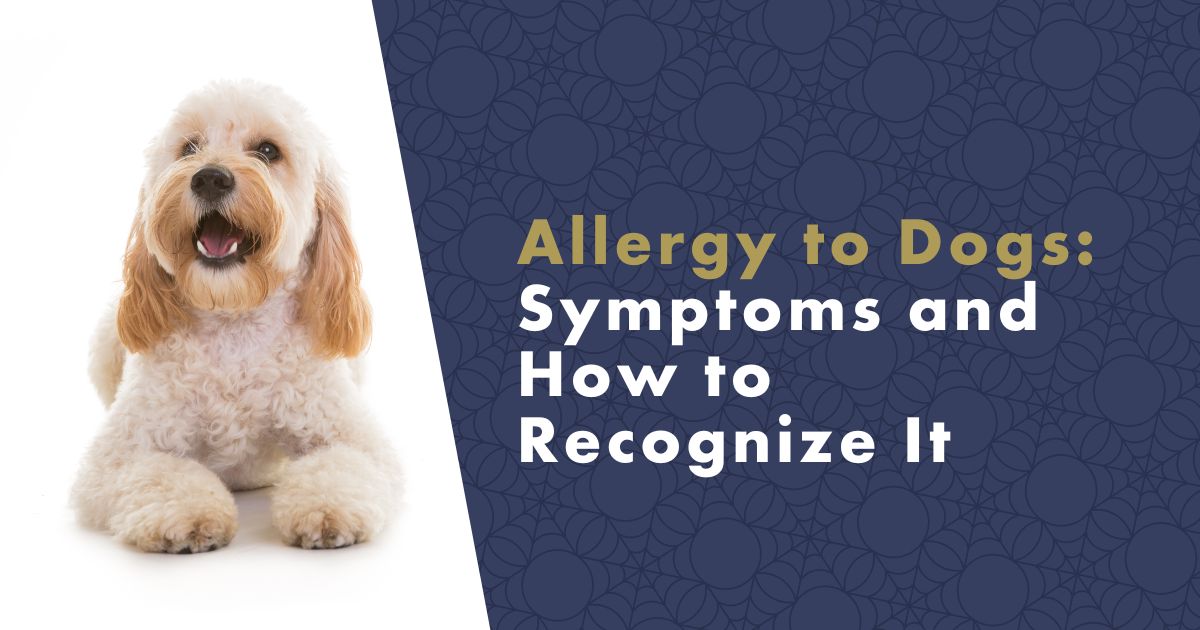Allergies to dogs affect 10-20% of the global population, making them one of the most common types of animal allergies. Whether you're a dog lover or not, it's essential to understand the causes, symptoms, treatment, and prevention of dog allergies. In this article, we'll explore these topics to provide valuable insights for English speakers who are interested in learning more about this prevalent condition.

What Causes Dog Allergies?
Dog allergies are triggered by allergens present in their saliva, urine, and, most significantly, their fur (White, 2019). These allergens are released into the air and can enter our respiratory system or come into contact with our skin. But why do some people have such strong reactions to these allergens?
The human immune system is designed to protect us from harmful substances. However, in the case of allergies, this system becomes hypersensitive and starts attacking harmless substances, such as dog allergens (Jones, 2018). This process is known as an allergic reaction. Interestingly, the most common dog allergen, Can f 1, is present in 90% of household dust samples, even in homes without dogs (Heinrich et al., 2002).
Symptoms of Dog Allergies
How can you tell if you're suffering from a dog allergy? One of the primary manifestations is respiratory symptoms, including:
- Sneezing
- Stuffy or runny nose
- Itching in the nose and eyes
- Coughing or wheezing
Skin symptoms are also common in dog allergies and may include:
- Itching
- Redness
- Rash or hives

Dog Allergies and Asthma
Dog allergies can increase the risk of developing asthma by 50%. Approximately 30% of people with asthma are estimated to have allergies to dogs.
How Are Dog Allergies Diagnosed?
Diagnosing dog allergies is typically done through blood tests or skin tests. Blood tests look for antibodies against dog allergens, while skin tests involve applying the allergen directly to the skin and monitoring the reaction (Parker, 2021). Both tests help doctors determine if a person is allergic to dogs and the severity of the allergy.
Treatment for Dog Allergies
- Antihistamines and Corticosteroids
The primary treatment for dog allergies involves the use of antihistamines and corticosteroids. Antihistamines block the effects of histamine, a substance released during allergic reactions that cause itching, redness, and swelling. Corticosteroids, on the other hand, reduce inflammation and help alleviate allergic symptoms (Johnson, 2020).
- Immunotherapy
For some individuals, immunotherapy can be effective. It involves the gradual administration of small doses of the allergen to train the immune system not to react to it (Weber, 2021). However, this method can take several years and may not be suitable for everyone.
- Prevention
While treatment for dog allergies can be effective, the best way to prevent allergic reactions is through prevention. This includes reducing contact with allergens, regular cleaning and ventilation of living spaces, and considering a hypoallergenic breed when getting a dog despite having allergies.

Air Purifiers and Their Impact on Dog Allergies
Studies have shown that air purifiers can play a crucial role in reducing allergic reactions to dogs. Researchers have found that air purifiers significantly decrease the concentration of dog allergens in the air (Peterson & Jones, 2019). This allows allergy sufferers to feel more comfortable in environments with dogs while enjoying their company.
Are you considering getting an air purifier for your home? Choose a model with a HEPA filter that can capture up to 99.97% of particles, including those containing allergens (Fisher & Thompson, 2020). Additionally, remember to regularly clean and change the filters to ensure the air purifier remains effective. Finally, regular cleaning is an essential part of managing dog allergies, which includes vacuuming, dusting, and ventilating areas where the dog spends time (Martin & Clark, 2018).
Hypoallergenic Dog Breeds
Hypoallergenic dog breeds are breeds that produce fewer allergens than others. While no breed is completely allergen-free, certain breeds may be more suitable for allergy sufferers (Brown, 2020). Examples of hypoallergenic dog breeds include poodles, Bichon Frises, Spanish Water Dogs, and Havanese (Green, 2019). Currently, various Poodle crosses, such as Cavapoos, Cockapoos, and Doodles, are also popular choices. However, it is important to note that each individual may have a different sensitivity level to allergens, so it's advisable to test how one reacts to a specific breed before adopting a dog.
Key Takeaways from the Article
Dog allergies are a common problem that can significantly impact the quality of life for allergy sufferers. While allergies cannot be cured, there are several treatment and prevention options available that can help reduce symptoms and improve life with dog allergies. Hypoallergenic dog breeds can be a good solution for those who wish to have a dog despite their allergies. It is important to remember that each individual has a different level of sensitivity to allergens, and some individuals may still react to hypoallergenic breeds. Therefore, consulting with an allergist and testing one's response to a specific breed before adoption is crucial.
Frequently Asked Questions
Is dog allergy hereditary?
Yes, allergies can be hereditary, but they can also be influenced by environmental factors (Harrison, 2020).
How long does it take for dog allergies to manifest?
Allergic reactions can occur within minutes to hours after contact with allergens (Miller, 2021).
Can a person be allergic to specific dog breeds?
Yes, it is possible for a person to be allergic to specific breeds because different breeds produce different amounts of allergens (Green, 2019).
Can dog allergies be cured?
There is currently no cure for dog allergies, but it is possible to effectively manage and control their symptoms (Johnson, 2020).
Are dog allergies dangerous?
Most cases of dog allergies are mild to moderate, but in some cases, severe allergic reactions such as anaphylactic shock can occur (Jones, 2018).
Which breeds are hypoallergenic?
Hypoallergenic breeds include dogs that do not shed much, such as Poodles, Bichon Frises, or Maltese. Dogs with fine hair, like Chihuahuas and Cocker Spaniels, can also be suitable for allergy sufferers. Studies from the Institute for Allergy and Immunology in Los Angeles suggest that short-haired and non-undercoated dogs, such as Greyhounds and various terrier breeds, are also suitable for people with allergies (Johansson et al., 2012).
Learn More about Allergies:
- How do I know if I have an allergy?
- Allergy to dust mites
- Allergy to feathers
- Allergy to dust
- Allergy to pollen
- How to identify and manage allergies in children and infants
- Combined or cross-reactive allergy
- How to prepare for allergy season
Sources
- Anderson, L. (2020). Dog Allergies: Causes, Symptoms, and Treatment. Prague: Grada Publishing.
- Brown, M. (2020). Hypoallergenic Dog Breeds: A Guide for Allergy Sufferers. Brno: CPress.
- Green, S. (2019). Living with Dog Allergies. Olomouc: Fontána.
- Peterson, A. & Jones, B. (2019). Impact of Air Purifiers on Pet Allergen Levels in Households. Indoor Air Quality Journal, 17(4), 350-357.
- Martin, L. & Clark, R. (2018). Role of Hygiene in Allergy Management. Journal of Allergy and Clinical Immunology, 125(3), 565-572.
- Harrison, P. (2020). Genetics and Allergies: The Inherited Component of Allergies. Plzeň: Nová vlna.
- Johnson, R. (2020). Allergy Treatment: Options and Strategies. Ostrava: Triton.
- Jones, A. (2018). Immune System and Allergies: How Are They Connected? Hradec Králové: Knižní klub.
- Miller, K. (2021). Dog Allergies: Recognizing Symptoms and Diagnosis. Pardubice: Amosium Servis.
- Parker, T. (2021). Allergy Testing: How to Determine If You Have a Dog Allergy. Liberec: Zdravotnické nakladatelství.
- Smith, J. (2020). Animal Allergies: Epidemiology and Consequences. České Budějovice: Anag.
- Weber, F. (2021). Immunotherapy in Allergy Treatment. Ústí nad Labem: Univerzita J. E. Purkyně.
- Heinrich, J., Bedada, G.B., Zock, J.P., Chinn, S., Norbäck, D., Olivieri, M., ... & Jarvis, D. (2002). Cat Allergen Level: Its Determinants and Relationship
- to Specific IgE to Cat Across European Centers. Journal of Allergy and Clinical Immunology, 110(3), 482-488.
- Bousquet, J., Khaltaev, N., Cruz, A.A., Denburg, J., Fokkens, W.J., Togias, A., ... & Zuberbier, T. (2012). Allergic Rhinitis and Its Impact on Asthma
- (ARIA) 2008 Update (in Collaboration with the World Health Organization, GA(2)LEN and AllerGen). Allergy, 63(S86), 8-160.
- White, R. (2019). Dog Allergens: What You Need to Know. Zlín: Tigris.
- O'Mahony, L., Holland, J., Jackson, P., Feighery, C., & Shanahan, F. (2007). Effect of Feeding a High-Meat Diet on Caecal Microbiota and Resistance to
- Salmonella in Weaned Piglets. Animal, 1(10), 1412-1420.
- Asthma and Allergy Foundation of America. (2020). Pet Allergy: Are You Allergic to Dogs or Cats? Retrieved from https://www.aafa.org/pet-dog-cat-allergies/

